Portugal
has a gastronomy which is as rich and varied as its countryside and its
heritage. However, it is the sea which has made the greatest impression
on Portuguese cuisine. A simple charcoal-grilled fish or a plate of
fresh seafood is always a guarantee of an excellent meal. When summer
arrives, the streets of the cities, towns and villages are flooded by
the smell and smoke characteristic of charcoaled sardines and, at the
seaside, the esplanade cafés serve a traditional octopus salad, clams
and an endless variety of freshly caught fish, in particular rock bass
(robalo), gilthead seabream (douradas), scabbard fish (peixe-espada)
and horse mackerel (carapaus).
But meat also forms
part of the nation's preferences. And cozido à portuguesa - a succulent
boiled mixture of meats, vegetables and stuffed sausages - is one of
the most appetising recipes in the world. If you are in the North, you
can also savour tripe (tripas) cooked in the style of Oporto, and a
type of feijoada, which can also be made à la transmontana in the
interior of the region. In the Alentejo, the bread-based açorda and
migas are two unmissable delights and if you travel near Bairrada do
not miss the opportunity to savour the famous Leitão assado (roast
suckling pig).
Wine and olive oil are also permanent
presences on the Portuguese table. Our national wine, considered one of
the best in the world, varies from region to region along with the
grape varieties. Portuguese olive oil, of great quality, is the base of
most of our traditional recipes, and in particular the soups and the
more than one thousand recipes for salted codfish (bacalhau) which are
said to exist.
And, to finish, let us not forget the delicious
national cheeses and desserts, especially those whose recipes were
forged in the convents, almost all made with eggs and sugar which make
us «give thanks to the Lord». At the end of the meal, if you want to
appear a true Portuguese person, always ask for a coffee. Drink a
strong espresso. Then you will understand why the Portuguese spend so
much time at the table.
- Oporto and North
- Centre
- Alentejo
- Algarve
- Madeira
- Azores
- The Olive Oil Route of Alentejo
- The Olive Oil Route of Trás-os-Montes
Oporto and North
The
gastronomy of Porto and the North of Portugal is amongst the most
varied in the country and includes fish and seafood from the coast and
tasty meats from the countryside. Make a «Portonic» (a mixture of Port
and tonic water) as an aperitif and start your meal with a
characteristic caldo verde broth. This, the most popular soup in
Portugal, has round slices of chouriço, with stuffed or smoked sausages
from the northern countryside, along with its famous hams from Chaves
and Lamego, its alheiras from Mirandela, or salpicões from Vinhais. You
can purchase all of these products at the annual Vinhais market fair.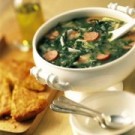
There
are different traditions along the coast, with fish occupying pride of
place in Matosinhos, Leça da Palmeira, Póvoa de Varzim and Viana do
Castelo. Some of the best salted codfish (bacalhau) recipes originate
from here and the sardine enlivens the coast, as well as the tradition
festival of S. João, in Porto. Fish and seafood are washed down with
vinho verde in the Minho region; whether red or white, it is always
served chilled. A definite choice is lampreia (lamprey), trout and
other river fish. 
The
famous red wines of Douro are best when accompanying pork dishes, which
in the north take the form of rojões or arroz de frango, which give off
heavenly flavours, or dishes of veal, whether barrosã, maronesa,
mirandesa or another kind.
Just room left for a delicious
dessert: in Braga it can be the creme caramel «Abade de Priscos», in
Amarante «Papos de Anjo» or the universal leite-creme or arroz doce
since their presence is always, at least in the north of Portugal,
guaranteed. And washed down with a glass of Porto to finish the banquet
from Porto and the North.
Centre
The Centre of Portugal has some of the most well-liked dishes in the Gastronomy of Portugal.
This
region, with its green forests containing some of the most ancient
historical and archaeological remains in the country, is an excellent
location to travel in, with one of the main reasons to do so being the
quality of its traditional gastronomy.
One good example of the
cuisine of the Centre of Portugal is the Leitão (Suckling Pig) from
Bairrada, eaten with a sparkling wine from the region. 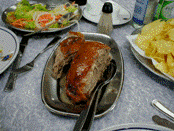
The
coast also offers seafood and fresh fish cooked in caldeirada and
ensopado dishes, which can also be prepared using fish from rivers and
lakes, all washed down with a white wine from Bairrada.
In the
sierras, you can try the Dão red wines with recipes for goat, such as
chanfana (cooked in red wine) or roast kid (cabrito assado) as well as
veal (vitela), cooked to a special recipe of its own in Lafões. 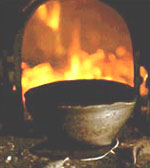
The
stuffed sausages (enchidos) of the countryside regions include
maranhos, morcelas de arroz and others, each one with its own
particular characteristic, such as a particular herb to imbue it with
flavour.
There are well-known cheeses, such as the famous
Serra da Estrela, Castelo Branco, Alcains or Rabaçal. Creamy or cured,
they are all excellent.
Alentejo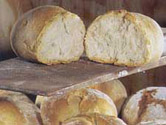
The Alentejo cuisine brings creativity to every dish with a characteristic flourish of imagination.
The
Alentejo has always been a great wheat region, sprinkled with cork tree
areas and large herds of pigs grazing on the plains. As such, bread
pork and olive oil are the bases of one of the most delicious cuisines
in Portugal, seasoned with herbs which bring the aromas of the fields
to the table.
Soup is a main dish, and may be cold when
gaspacho, filled with bread in the sopa de cação, or salted codfish
(bacalhau) or tomato or the linguiça stuffed sausage. Bread also forms
part of the migas dumplings which accompany pork and lamb (ensopado de
borrego) or the simple Alentejan açorda. You can try these delights in
any restaurant in Estremoz, Évora or Beja, or also a dish of game,
which is also very characteristic of the cuisine of the Alentejo and
which provides a real taste of pleasure!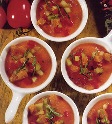
This
is also the case on the coast, where fish and seafood take on a special
flavour. If you have never heard of the quality of the fish of the
Southwest Alentejo, then you do not know what you are missing?
Also
not to miss are the regional cheeses and the desserts originating from
the religious convents. Cheeses with a particular good reputation are
those from Nisa, Serpa and Évora, which is also an appropriate excuse
to try a red wine from Borba, Redondo, Reguengos or Vidigueira. The
desserts' well, there were many convents in the Alentejo and for all
the work of the nuns, beating their eggs with sugar and almonds, we
give thanks to God!
From Sagres to Guadiana, the Algarve is a region of
sun, fish and seafood. The quality and variety are so great that a
grilled fish or some barnacles eaten on the Vicentine coast can seem a
true delicacy from the Gods. There are also the region's own recipes
worth mentioning, with cataplanas, caldeiradas, fish soups or starters
or hors d'oeuvre (petiscos and acepipes) that provide relief to any day
on the beach, playing golf or just fine weather.
Try
some horse mackerel (carapaus) or the traditional charcoaled sardines
in Portimão. Order them with a Cacela mountain salad, and see that
there is nothing finer than tasty simplicity. 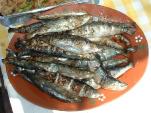
Or
tuna steak in Tavira or octopus, from Santa Luzia. The Algarve is an
excellent place for this fare, as well as the delicious clams, cockles
, razor clams, and oysters from Baleeira, Alvor and the Formosa river
or the little squid and cuttlefish ever present in the Algarve - after
all, it is a home to the fishermen!
However, the Algarve also
has a sierra and recipes coming down from the land such as boiled chick
peas, or the fruits which flavour desserts, such as almonds, oranges
and figs, as well as the «Morgados» and «Dom Rodrigos» cakes which
nobody can resist? Among these fruits are those which provide flavour
to the liqueurs and spirits (aguardentes) such as medronho da serra and
amêndoa amarga, the latter to be drunk when chilled.
What more do you want for a romantic dinner, afternoon or a chance to set the world on fire?
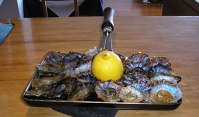
Madeira
has its own characteristic gastronomy, which mixes the Atlantic with
the exotic, which can be sampled in the elegant surroundings of the
numerous hotels and resorts.
Right in the Atlantic, the fish and
seafood of the archipelago are tasty and cooked in traditional ways,
such as fillets of black scabbard fish (peixe-espada preto) or tuna
steaks (bifes de atum), served with crispy fried maize; there is also
octopus and delicious seafood, such as limpets and winkles.
The most traditional meat dish is the famous beef on a skewer made of a laurel stick, which gives it a unique flavour.
With
its exceptional climate, Madeira grows a large variety of crops, in
particular sugar cane and tropical fruit (such as the much appreciated
banana, pineapple and passion fruit), to be found in the drinks and the
delicate desserts.
The famous Madeira wine, whether drunk as
an aperitif or digestif, goes well with the traditional honey cake
(made with sugarcane honey). Sugar cane is also used to make the
aguardente to mix in to the famous punch, to be tried when climbing the
Pico do Areeiro.
Finally, we just need to mention the bolo do
caco. Except that this is not a bolo (cake) but a type of bread, which,
through being baked on a piece of tile, was given this name. It is also
worth mentioning that bread is also made from sweet potatoes in
Madeira: you will just have to try the appetising ring-shaped biscuits
(rosquilhas) made from this sweet-potato.
If you travel to
Porto Santo, the other island in the archipelago equally blessed with a
seaside life, let yourself be rocked by the memory of the meals and
good moments experienced on Madeira.
In the nine islands of the archipelago, the seafood is amongst the tastiest, and there are barnacles and limpets to offer a gastronomic delight on all the islands. Fish can be grilled freshly caught, or cooked in caldeiradas or fish soups. Stewed octopus is another common delicacy.
The rump of beef from Terceira island is well known throughout the islands as well as the much enjoyed boiled meat dish cozido das Furnas, on the island of S. Miguel, where hermetically sealed containers are placed under the earth and the food is cooked in the natural heat present in the ground. And there is also the traditional recipe for yams with the linguiça sausages from the various islands.

The islands are home to excellent cheeses. The most famous of these is that of the island of S. Jorge, which in continental Portugal is simply known as «cheese of the island» (queijo da ilha).
Any talk of wines requires mention of verdelho, the Pico variety being the most well known, with the picturesque patchwork countryside of the wine growing region having received the status of a UNESCO World Heritage site, not to mention Biscoitos wine, from Terceira Island.
As regards desserts, pastries are the most common, but there are also tasty queijadas from the island of Graciosa and other desserts on each island. But do not forget to try the pineapple from the Azores; the sweet taste will leave you will an excellent souvenir of your stay on each island.
The Olive Oil route of the Alentejo 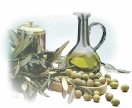
Light
density, fruity, with the colour of gold and sometimes with a light
green tone. That is the olive oil of the Alentejo, an essential
ingredient of Portuguese cuisine and one of the local gastronomic
treasures. The Olive Oil Route of the Alentejo includes the Protected
Designation of Origin (DOC) areas and leads visitors through the aromas
and flavours of the olive oil produced in Moura, Serpa, Portel,
Vidigueira, Cuba, Alvito, Viana do Alentejo, Ferreira do Alentejo and
Beja.
In Moura, visit the Olive Oil Museum - the Lagar de Varas
do Fojo, dating from the 19th Century, and get to know how oil was made
100 years ago. At the end of the visit, you can satisfy your stomach in
Serpa with a few pieces of coriandered port with a generous amount of
that nectar and discover the true meaning of the phrase «as fine as the
olive oil from Moura».
Keep on the Olive Oil Route further into
the Alentejo region and follow it until Beja. Any district you pass
through will have a cooperative with its doors open so you can try an
olive oil made from ripe olives, and the slight bitterness of apples or
figs.
You should also visit one of the oil presses in the
Northern part of the Alentejo to sample the more perfumed olive oil
which is produced there.
To know more:
Azeites do Alentejo
The Olive Oil route of Trás-os-Montes
The
olive oil from Trás-os-Montes is a balanced nectar, with a smell and
taste of fresh fruit, sometimes with a flavour of almonds, and a
notably sweet, green, bitter and spicy sensation. It is produced
between Mirandela and Vila Nova de Foz-Côa, taking in the various
parishes and districts of Valpaços, Murça, Torre de Moncorvo,
Mogadouro, Vimioso and Bragança. The olive tree plantations of this DOP
occupy an area of approximately 40,000 ha.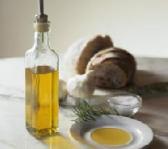
The
label the Olive Oil Route of Trás-Os-Montes is not an exact
geographical designation, as it takes in the areas of Trás-os-Montes
and the Alto Douro, but from the fact that the product has a DOP
(it is certified as coming from a region with a Protected Denomination
of Origin). Olive oils which wish to use the label have to be produced
in accordance with the rules which have been laid down for this label.
Those
included in this route come from olive trees planted in the schist
terrain, which is characteristic of the region. The geographical
and climatic conditions enable the olives grown to have an exceptional
quality which, when harvested at the right moment, and selected and
cleaned, produce pure olive oil.
The Olive Oil Route of
Trás-Os-Montes was designed with the concern to reencounter what is the
most genuine and authentic in the Trás-Os-Montes and Alto Douro region,
such as the wild but beautiful countryside and a gastronomic tradition
linked to the art of great hospitality which all of those involved in
the Route share.